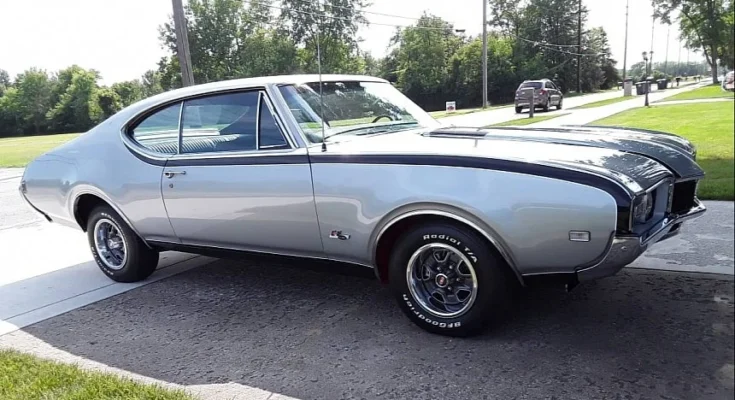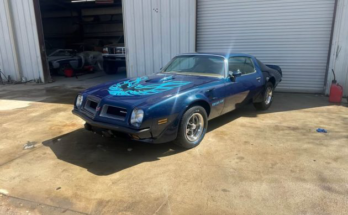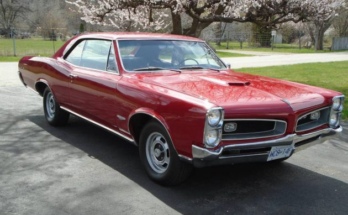Insert screeching vinyl record noises here, and scratch your heads in disbelief. Pontiac reacted first – they had a very Super Duty honor to defend – and put out the GTO. The grumpy brass hats omitted – or perhaps left an open back door – to specify that the edict ruled out standard engines bigger than 400 cubes.
There was nothing in the books about optional powerplants. The sleuths from Pontiac rubbed their hands and promptly dropped a 389 motor in a LeMans, dubbed it the ‘GTO package,’ and made history. A few short months after, in April 1964, Oldsmobile tried a similar move but failed.
The 4-4-2 option on the Cutlass and F-85 wasn’t nearly as appealing as the GTO. Worse still, the execs from Olds chose the worst possible time in the entire history of automotive to introduce their performance offer. April 1964 – what happened then, I wonder? The Barracuda broke ground on the first day of the month.
But that wasn’t a big enough event to deflect attention away from Oldsmobile’s new proposal. The Ford Mustang was presented on the 14th – and everything else faded into obscurity. Fatefully, Olds’ boys chose the same New York World Fair to announce the B9 package (that’s what the 4-4-2 Regular Production Option code was).
Predictably, sales weren’t great at all. As far as mid-size wars went, Chevrolet was beating its corporate siblings badly with the introduction of the Chevelle – yet another reason for the 4-4-2 to slide into anonymity. But the oldest carmaker in America at the time wasn’t going to let things get out of hand: in 1965, the 400-cubic-inch V8 was introduced in the mid-size lineup.
It was a trumpet call to rally the horsepower armies under one flag toward a mutual goal, against a common enemy. The final assault came in 1968 when Oldsmobile played a sleight-of-hand of big-block proportions on absolutely everyone, masterfully finding a loophole in the GM edict, and taking advantage of it.
The beauty of it was that it did it in plain sight, teaming up with Hurs-Campbell, Inc., and Demmer Engineering to produce the Hurst-Olds 455. Guess what the number stood for? Exactly – piston displacement, expressed in cubic inches! Oldsmobile cleverly disguised their hairy-backed muscle ruffian under someone else’s uniform and walked away with it unharmed.
Granted, only 515 of those very muscle-bound enormities were ever made (much to the sorrow of today’s gearheads). Still, each and every one of them counts. 390 horsepower wasn’t the tip of the horsepower iceberg in the late sixties, and offers were plentiful from absolutely anyone who was someone in the go-fast industry.
Mother Mopar was leading the pack with its 426 Hemi and 440 big blocks; Pontiac was hot on its tail with the nefarious 400 V8 and its 370+ hp; Ford was slinging the 427 Cobra V8 with dual-quads; Chevrolet dropped the mic with the 396 (not to mention the COPO cars). Oldsmobile had to do something.
The Hurst-Olds 455 was a 4-4-2 in disguise; in fact, it was very similar to the model (the 4-4-2 became a separate series in 1968 instead of a package), what with its silver livery with black stripes. The paint was actually borrowed from the Toronado (Peruvian Silver), and so was the hot-rodded 455-cube monster motor.
With big-valve heads, a lumpy camshaft, tuned carburetor and distributor, and the Force-Air twin-scoop induction system from the W30 package, the 455 H-O (short for Hurst-Olds, not to be confused with Pontiac’s ‘High Output’ acronym) was a locomotive.
Not a metaphor, at 500 lb-ft; the 426 Hemi and its 490 lb-ft was not the top dog anymore. With enough crank spin to twist the Earth’s axis into a pretzel, the 1968 Hurst-Olds 455 wasn’t just a tire smoker; it came with something other muscle cars raised their noses at: air conditioning. Granted, that cost ten horsepower, but so what? With a dual-gate shifter under their right hand, drivers of one such unicorn looked cool and rode cool, thanks to the climate-controlling system.
Orders for one poured in like liquor after the Prohibition. Still, Oldsmobile decided not to stretch it, and it didn’t push its luck overboard. Production kicked in gear late in the model year, with the company dispatching assembled cars (with the 455 V8s in them) over to Demmer Engineering in Lansing, Michigan, which converted them to Hursts.
Initially, only 500 vehicles were slated for build, but an influential dealer from the Lansing area asked – and received – an increase to 515. At the end of the month (literally, the cars were converted within 30 days), the tally indicated 451 hardtops and 64 pillared coupes. The four convertibles used as promo cars are not included in this count.
Over the following two decades, nine other versions of Hurst-Olds cars were produced (in and out, as there wasn’t a strict generational hierarchy), all thanks to this mutiny from Oldsmobile in 1968. While not nearly as coveted as in-period GTOs, GTXs, Chargers, Road Runners, Chevelles, Torinos, or Grand Sports, a 1968 Hurst-Olds 455 is still a treasure among gearheads.
As with all classics, matching numbers add value to it, but a pristine example with a correct replacement big-block is nothing to sneeze at, either. Take a look at the example in the gallery and drop a comment if you think it’s worth the asking price of seventy grand. The Hobart, Indiana, owner points out a restoration completed three years ago (with ‘everything new and replaced’) and stresses out the D-heads and OW transmission on the rebuilt 455 powerhouse.
In fact, the list of parts on this 37,000-mile classic muscle car is too long to compile in the Craigslist ad, and the seller warns that only serious inquiries from interested prospects will be considered. If you want to see the car in person, you must call in advance – texts or emails are discarded.









